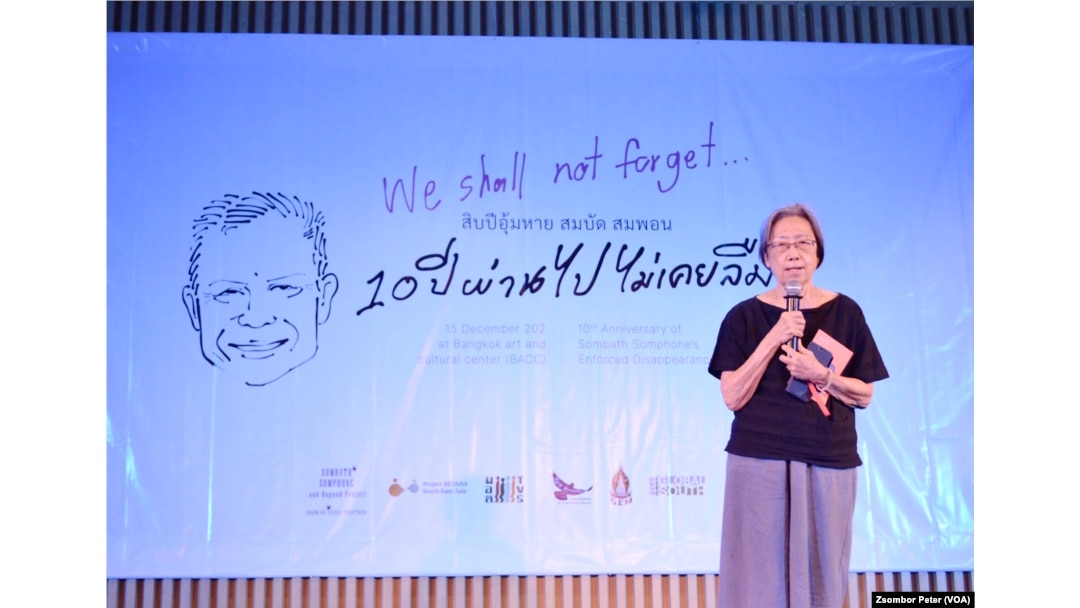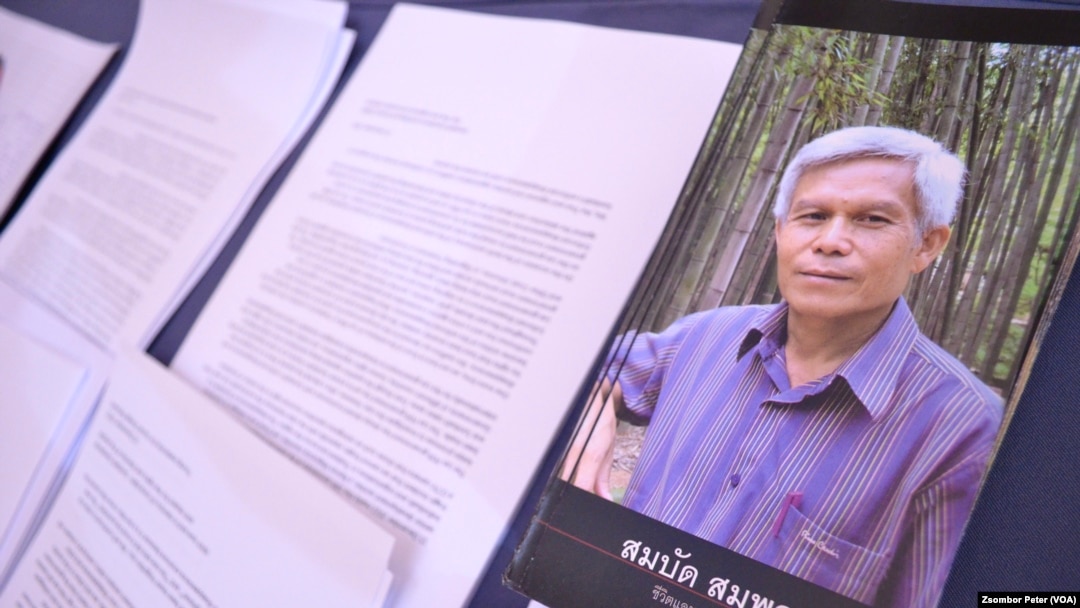In the fading evening light of December 15, 2012, on a busy road in the Lao capital of Vientiane, Sombath Somphone, a tireless and renowned advocate for his country’s impoverished farmers, vanished without a trace.
In CCTV footage captured by a roadside camera, Sombath is seen being pulled over at a police post, stepping out of his jeep, and getting into a pickup truck that drives him away.
His wife, Shui Meng Ng, who was driving home to have dinner with Sombath just ahead of him in another car, has not seen or heard from him since. Ten years on, she is still demanding answers about the suspected abduction from Lao authorities, who deny any knowledge of his fate, and drawing attention to the hundreds of other cases of enforced disappearance across Southeast Asia.

Shui Meng Ng, the wife of Sombath Somphone, speaks at an event in Bangkok, Thailand, Dec. 15, 2022, marking the 10-year anniversary of her husband’s enforced disappearance in Laos.
The United Nations defines enforced disappearance as an arrest, detention or abduction by state agents or their proxies, and the state’s refusal to acknowledge the event or disclose the victim’s fate. The U.N.’s working group of enforced disappearances counts 1,303 unsolved cases across the region as of May this year.
In Laos, Ng says the authorities have given her no update on Sombath’s case and have refused to even meet with her since 2017. If she could face them again, she says she would tell them what she has been saying for the past 10 years.
“Tell me what happened to Sombath, tell me the truth, tell me where he is right now,” she said in an interview with VOA. “If he has committed any crime, please charge him according to the law. That has been my appeal. Just give me the truth, just let me know where Sombath is and what had he done.”
Living with the mystery of Sombath’s fate has been “terrible,” Ng added.
“You live with this unknown, this blank wall that you’re staring at, and without any information, without any knowledge of what happened to him, without any knowledge that whether he’s still alive, and if he’s alive what kind of situation that he is in,” she said. “This has been weighing on my mind for the past 10 years.”
Educated in Laos and the United States, Sombath dedicated his professional life to teaching Lao farmers new techniques and how to have their say in the development of their communities. He won the U.N.’s Human Resource Development Award in 2001 and Asia’s prestigious Ramon Magsaysay Award for Community Leadership four years later.
Before he disappeared, Sombath had also been questioning a number of government-backed land deals that were leaving families homeless with little or no compensation.
In a tiny, communist, one-party police state like Laos, Ng said she did not believe the authorities could not track down Sombath, or find out what happened to him, if they wanted to and called their investigation “a sham.”
Angkhana Neelapaijit, a Thai human rights advocate and member of the U.N. working group, said the CCTV footage offered an uncommonly strong lead for an enforced disappearance case.
“From my experience, almost all cases don’t have the evidence ... they have no pictures, they have no video clip,” she said. “But for Sombath I think it’s quite clear. We have evidence he was asked to stop at the checkpoint ... and after that he disappeared.”
The authorities’ claims to know nothing about what followed, she said, showed “a lack of sincerity and transparency.”
T-shirts of Sombath Somphone are displayed at an event in Bangkok, Thailand, Dec. 15, 2022, marking the 10-year anniversary of his enforced disappearance in Laos.
VOA could not reach the Lao police for comment. Multiple calls to a spokesman for the government went unanswered.
Of the 1,303 unsolved cases of enforced disappearance counted by the U.N. in Southeast Asia, two countries alone — the Philippines and modern-day East Timor, previously part of Indonesia — account for three-quarters. Most date back decades.
But Angkhana, whose own husband, Somchai Neelapaijit, disappeared under suspicious circumstances in Thailand in 2004, said enforced disappearances were still happening across the region. Of Southeast Asia’s 11 countries, only Brunei and Singapore have no outstanding cases, and some have racked up new ones in recent years.
The official numbers, Angkhana added, are very likely just the “tip of the iceberg,” as families are often too scared of falling afoul of the same authorities suspected of committing the abductions to even report a case.
Creating that fear is one of the very reasons governments still do it, said Katia Chirizzi, deputy Southeast Asia representative for the U.N. Office of the High Commissioner for Human Rights.
“In Southeast Asia the practice has traditionally been used by states as a means of silencing political opponents or critical voices,” she said at an event in Bangkok Tuesday marking the anniversary of Sombath’s suspected abduction.
“Indeed, enforced disappearance has frequently been used to spread fear and send strong messages to other individuals who courageously raise their voices on critical issues of public interest and concern,” she added, with victims ranging from human rights defenders to “environmentalists, social and political activists, government critics, lawyers and journalists.”
“They try to scare the other activists,” said Siriphorn Chaiphet, a Thai youth volunteer organizer who helps run the Sombath Somphone and Beyond Project, which advocates for justice for Sombath and other victims of enforced disappearance.
“If one person disappears, for sure other people will think they will come [for] us soon,” she told VOA.
Ng remains undeterred.
She continues to live and work in Laos and came to Bangkok this week to continue raising awareness of the enforced disappearance of her husband and others, and to demand answers. She met with foreign diplomats Wednesday, helped lead a rally outside the Laotian embassy Thursday morning, and joined a series of events celebrating Sombath’s work in the afternoon.
She said many have urged her to give up.
“But I can’t do that ... It’s not right. I can’t do that to myself. I can’t do that to Sombath. I have to keep asking and try to find out the truth,” said Ng, while keeping hope alive that she will see him again.
“Like all victims, families of people who have disappeared, we pray, we hope,” she said. “It is that hope that I will find him and he will come back that keeps me going, waking up every morning and trying to go on, to live on, to carry on with my life.”


